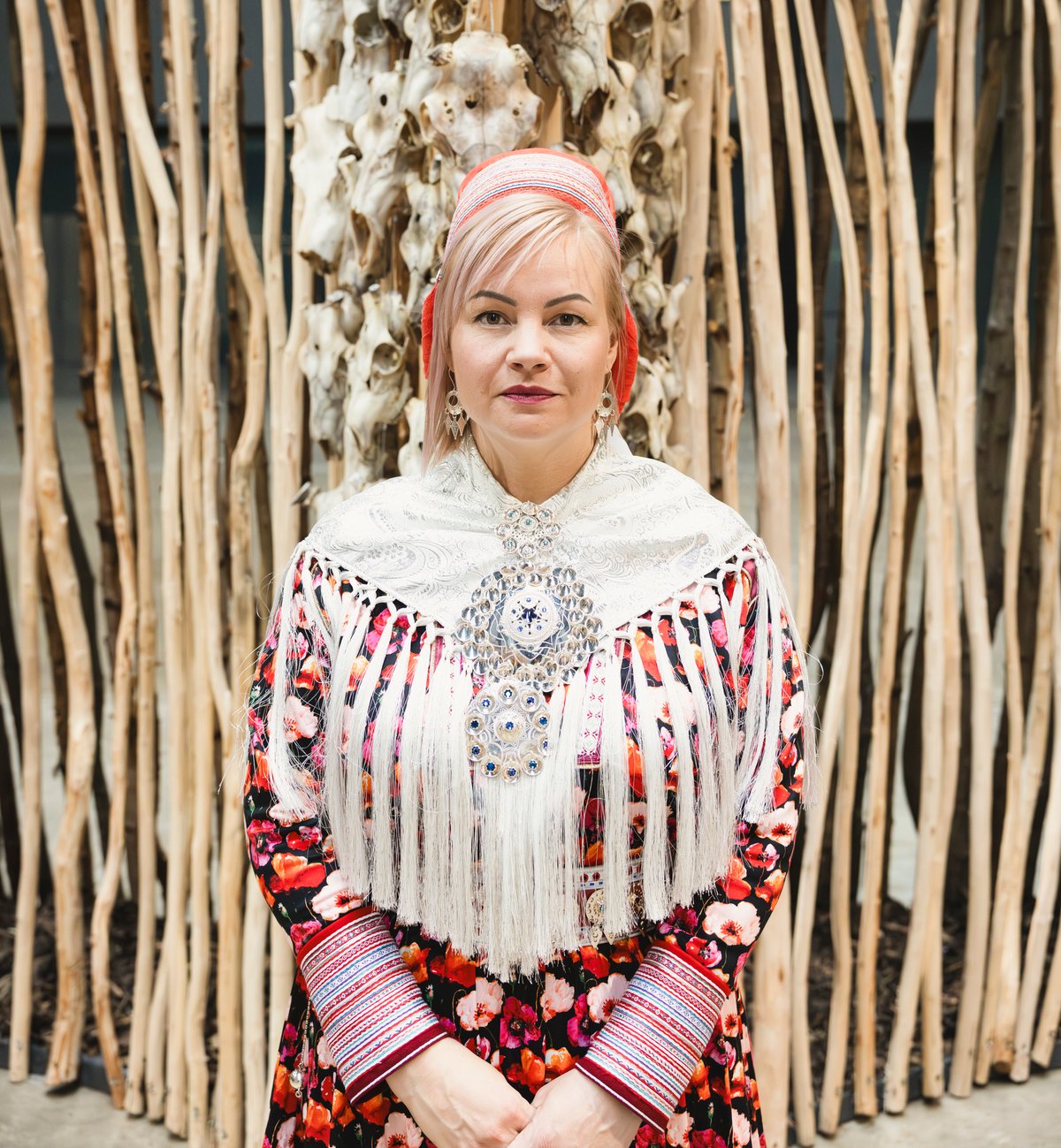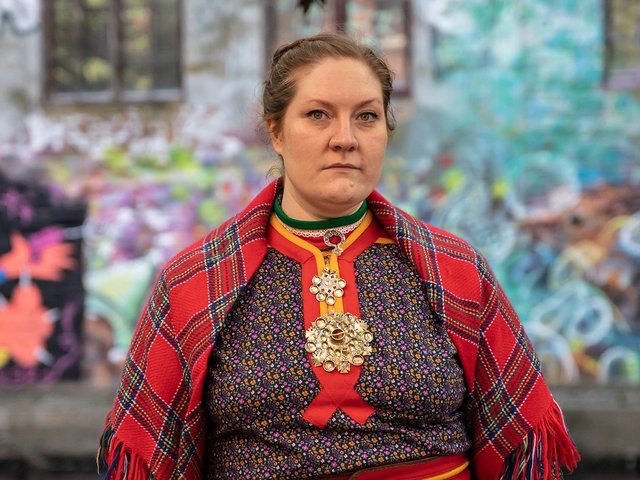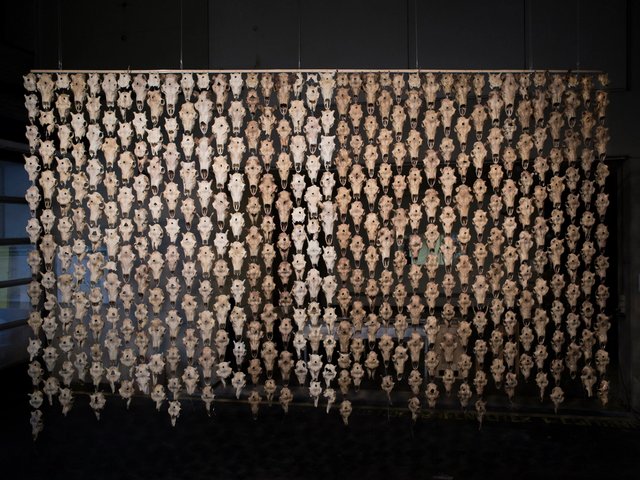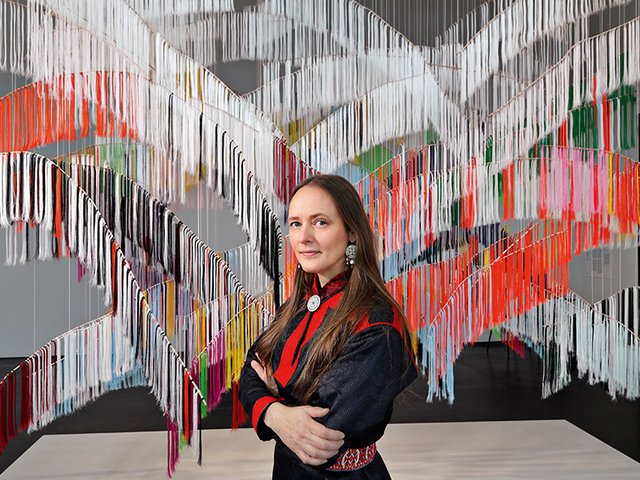This year’s Hyundai Commission at Tate Modern is by Máret Ánne Sara, a Sámi-Norwegian artist who makes sculpture and installations using the materials that surround her and sustain her community in Sápmi, the territory of the indigenous Sámi people, which spans northern Norway, Sweden, Finland and Russia. Sara’s monumental new Turbine Hall installation is her first major work in the UK. The artist’s other significant international exhibitions include the 59th Venice Biennale in 2022 and Documenta 14 in Kassel in 2017.
The Art Newspaper: Your Turbine Hall commission has two interrelated elements: Goavve, a sculpture made from reindeer hides, electrical elements and LED lights, which stretches the full 26m height of the Turbine Hall, and at one end of the Turbine Hall, Geabbil, a maze-like structure that is based on the anatomy of the reindeer’s nose. Can you explain the works’ conjoined title of Goavve-Geabbil?
Máret Ánne Sara: Goavvi (the nominative form of goavve) is a Sami term that you could translate as “locked pastures”, and it’s a result of increasingly unstable environmental conditions in the Sápmi Arctic region. We used to have cold, dry stable temperatures in the winter months, which made good grazing; but now due to the fluctuations of climate change, we have much wetter winters and temperatures fluctuating from -40ºC to above 10ºC. When rain falls on cold ground, it freezes into an ice crust that traps the lichen underneath. Layers of ice or compacted snow can build up and prevent animals, including reindeer, from accessing the food underneath. We’ve had five consecutive years with goavvi occurring in Sápmi, so it represents my lived reality, but I find it equally relevant for the entire world because it parallels extreme weather and ecological situations that are happening everywhere, in different forms.
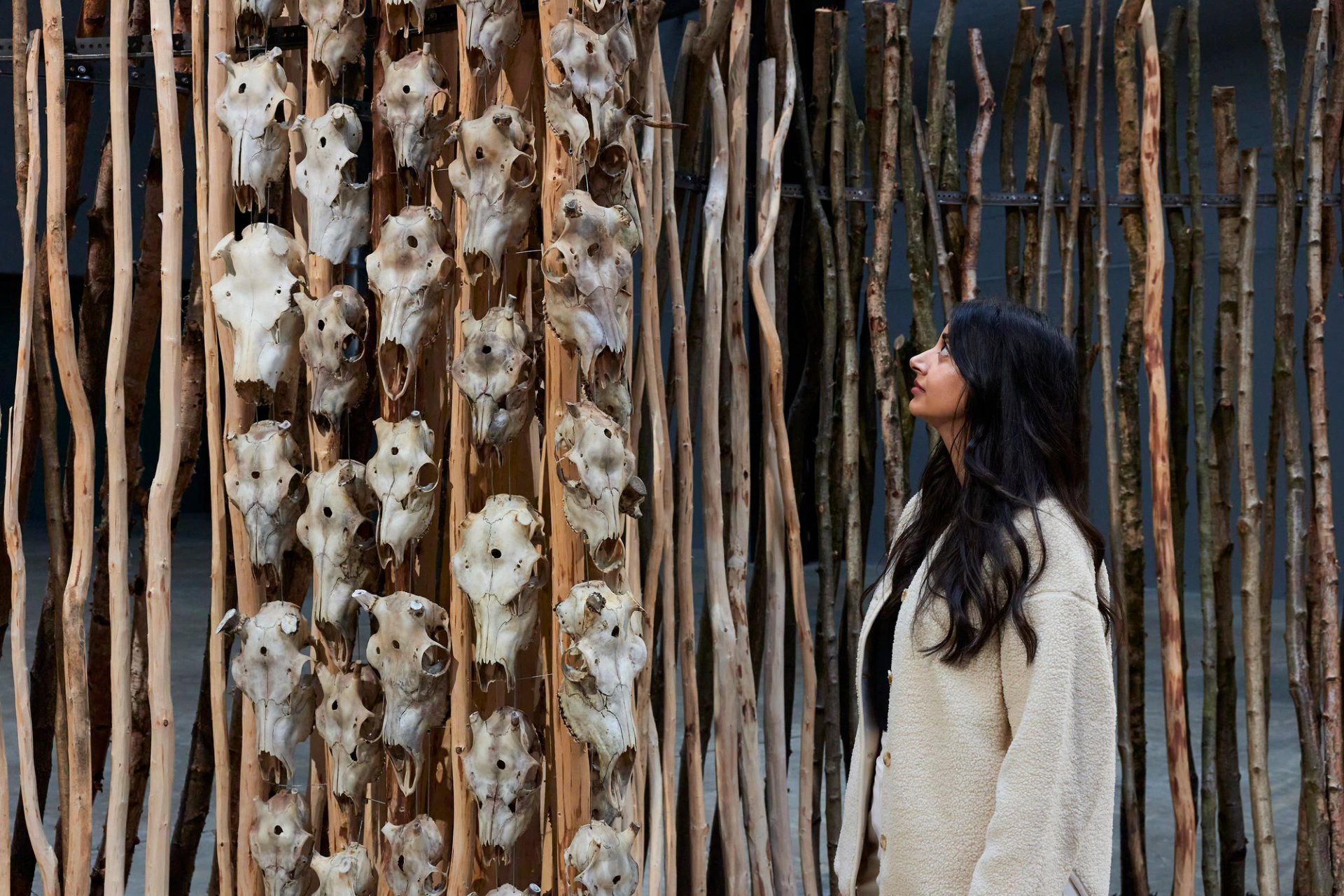
Sniffed and heard: a reindeer danger-signal pheromone, along with the smells of lichen and mountain herbs, is pumped through Geabbil, while noises from the tundra mingle with the chant of joik Photo © Tate (Yili Liu)
Then geabbil is a North Sámi word meaning flexible or smartly adaptable, and this reflects my search for alternative strategies for a more sustainable global future, looking beyond the modern Western capitalist logic, but rather from within Sámi and Indigenous philosophy.
Both sculptures incorporate reindeer hides as well as electrical cables. To what extent do these materials refer to the impact of both mineral extraction and renewable energy projects on traditional lands and reindeer-herding routes?
I have a close relationship with my materials, both spiritually and philosophically—that’s the way I work. By bringing hides here, I’m bringing the energy and the life from these animals and from the region where I come from. It’s a very powerful energy. Then combining them with these power cables, where they are trapped and entangled with each other, opens up a possibility to reflect on the greenwashing or green colonisation that we are in the midst of, especially in Sápmi, and to consider what is important in this need for energy and light. Wind farms, power lines and the infrastructure that they generate are eating their way through calving lands, migration pastures and the landscapes that we depend on for Sámi reindeer herding, which in turn sustains Sámi philosophy and knowledge systems. Sámi people are being displaced from their lands under the guise of conservation and sustainability. It’s a very complicated and difficult battle for us in Sápmi.
And of course Tate Modern itself is housed in a former fossil-fuel power station.
Yes, and I use the power cables not only to represent electricity, but also the extractivist logic of modern human society, to fuel our consuming habits, and within that comes mining, for instance.
In our region, we are currently battling a huge mining project called Nussir, which is owned by the Canadian company called Blue Moon Metals. This horrific example of extractivism disguised as an environmental project will be allowed by the government to dump 30 million tonnes of toxic waste into a healthy fjord and to blow up sacred calving lands. Yet the lights in both the Turbine Hall structures are also a futurist reference to viewing indigenous and Sámi knowledge systems and philosophy not as something outmoded or ancient, but rather as opening the possibility of their great value as future thinking for all. When Tate Modern first asked me why I wanted the lights, I instinctively said: “It’s the spiritual pathway as well.”
You come from a Sámi reindeer herding family and originally trained as a journalist. What made you turn to making art?
Need, basically. I didn’t choose art for the luxury of being an artist, but because the structures within our societies have been shaped by the colonial apparatus and are not working for us. I felt helpless within these structures, and the mistrust from colonial systems towards me as a reindeer herder. So art became necessary since nothing else helped.
Also creativity is embedded within the nomadic Sámi way of life: you have to teach your brain creativity to survive in all circumstances. It was such a gift to discover Gregory Cajete [the Tewa author and professor from Santa Clara Pueblo, New Mexico] whose idea of “indigenous science” offers a definition and a framework around the knowledge and perceptions gained by a close participation and co-existence with the natural world. Calling these dialogues and co-existence with other life-forms “science” makes sense of them from a modern, Western perspective and in many ways describes how I engage in art. I almost never sit at a drawing board or make sketches; my body intuitively knows what to produce.
Right from the beginning of your career, reindeer have been both your material and your subject matter. Why has it been so important to put them front and centre of your work?
It is so much more than just growing up with reindeer. You know those artists who express themselves by using their body, by piercing or hanging themselves [up]? For me the reindeer is the closest thing to this, because there is this close physical, spiritual and also existential link between us. That link is at the core of indigenous science.
And the form of Geabbil is based on the anatomy of the reindeer nose.
The reindeer nose is extraordinarily energy-efficient. Scientists have discovered they can heat the air by [up to] 80ºC within a second. So by entering this space and finding yourself smaller than this little part of a smartly adaptable animal nose, hopefully you have to readjust your perception of yourself as being above everything else. Just for you to feel that bodily inferiority and to navigate a space that contains both natural intelligence and also the power of indigenous philosophy and science—maybe that becomes spiritual as well.
And you have also filled the Turbine Hall with your most extensive soundscape to date.
It’s a collage of different sounds. There’s the Sámi musical practice of joik, which uses the voice to evoke the essence of a person, animal or place and to channel their energy, and I’ve used a collection of these. Then there are the sounds of reindeer, and the sound of millions of mosquitoes that I made one summer. It also includes the funny sounds my son made when he was breastfeeding.
Then in a deep listening section in Geabbil you can sit on reindeer hides and listen through earphones to interviews I’ve done with different Sámi knowledge keepers. Some are academics, some reindeer herders, some family members. This is an invitation to enter a different way of understanding the world and your position in it as a human being. For me, indigenous philosophy and thinking shouldn’t be viewed as something outdated and old, but rather something that’s progressive and desperately needed in our time of crisis. The whole piece is an experiment for you to see and understand the world and yourself in it from a very different perspective that might be useful and interesting for us all collectively to think about a way forward.
• Hyundai Commission: Máret Ánne Sara, Tate Modern, until 6 April 2026


